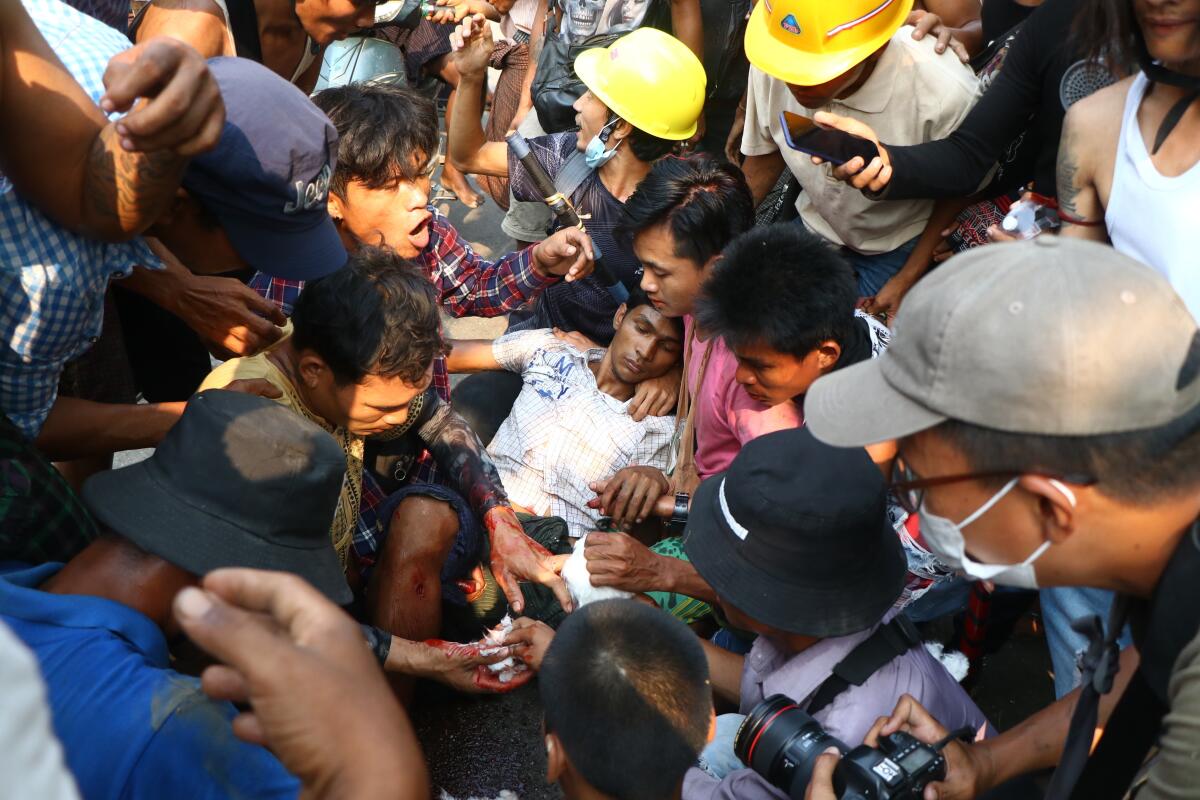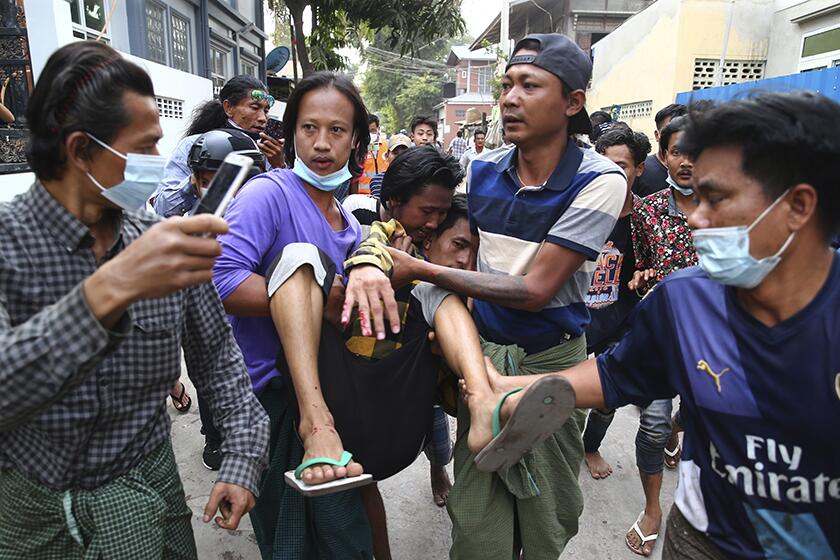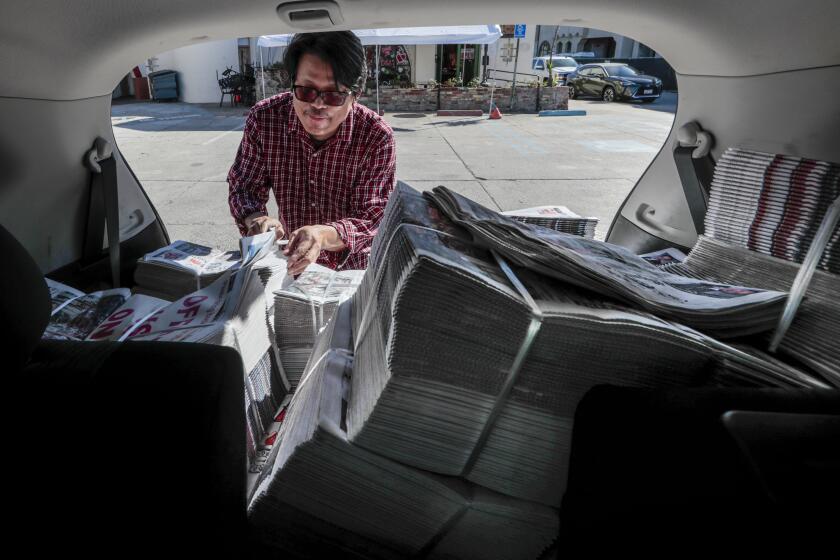Martial law imposed in parts of Yangon as Myanmar deaths rise

- Share via
YANGON, Myanmar — Myanmar’s ruling junta has declared martial law in six townships in the country’s largest city, as security forces killed dozens of protesters over the weekend in an increasingly lethal crackdown on resistance to last month’s military coup.
State broadcaster MRTV said Monday that the Yangon townships of North Dagon, South Dagon, Dagon Seikkan and North Okkalapa have been put under martial law. An initial announcement was made late Sunday saying two other townships — Hlaing Thar Yar and neighboring Shwepyitha — were being placed under martial law.
At least 38 people were killed Sunday and dozens injured in one of the deadliest days of the crackdown on anti-coup protesters, according to the Assistance Assn. for Political Prisoners, or AAPP, an independent group tracking the toll of the violence. Several estimates from other sources gave higher figures.
Complicating efforts to organize new protests as well as media coverage of the crisis, mobile internet service has been cut, though access is still available through fixed broadband connections.
Mobile data service has been used to stream live video coverage of protests, often showing security forces attacking demonstrators. It had been turned off from 1 a.m. to 9 a.m. for several weeks, with no official explanation.
The blockage of internet service forced postponement of a court hearing in the capital, Natpyitaw, for Myanmar’s detained leader, Aung San Suu Kyi, who was supposed to take part via a video conference, said her lawyer Khin Maung Zaw. Suu Kyi and President Win Myint were detained during the Feb. 1 military takeover and have been charged with several criminal offenses that their supporters say are politically motivated.
More than 2,000 people have been arrested, many in their homes, in a bid to quash resistance to the junta. Two Myanmar officials have died in custody.
Since the military takeover six weeks ago, Myanmar has been under a nationwide state of emergency, with its civilian leaders ousted and detained and military leaders in charge of all government. But the announcement on state broadcaster MRTV late Sunday appeared to be the first use of the term “martial law” since the coup and suggested more direct control of security by the military, instead of by local police.
The announcement said that the State Administrative Council had acted to enhance security and restore law and order and that the Yangon regional commander had been entrusted with administrative, judicial and military powers in the area under his command. The orders cover six of Yangon’s 33 townships, all of which suffered major violence in recent days.
Thirty-four of the deaths were in Yangon. Video from Hlaing Thar Yar township showed people running away after gunfire was heard at night. Those fleeing carried one injured person and tried to revive two others, one who seemed to be dead or dying, the footage from the independent Democratic Voice of Burma showed.
Hlaing Thar Yar was the location of 22 civilian deaths Sunday, according to the AAPP, which said more than a dozen civilians were wounded and described a large number of junta forces engaged in the township.
Thakhin Kai Bwor is the editor of the Myanmar Gazette, the only Burmese-language newspaper in the U.S. For many readers, it’s also a how-to guide for life in America.
Four other deaths were reported in the cities of Bago, Mandalay and Hpakant, according to the AAPP and local media.
In Yangon, video posted on social media showed crowds of people, some wearing hard hats and gas masks, running down a street amid sounds of gunfire. The demonstrators quickly sprayed fire extinguishers as they retreated — a tactic widely used to smother tear gas and create a vapor screen that makes it harder for police to pursue or shoot demonstrators.
In a new tactic, anti-coup demonstrators used the cover of darkness to hold mass candlelight vigils Saturday and Sunday nights in a Yangon commercial area that was usually the scene of their daytime protests. After-dark rallies were also held in Mandalay and elsewhere.
The protest movement has been grounded in nonviolent civil disobedience from the start, with marches and general strikes among its main features. But some protesters have advocated stronger, more agile methods of self-defense — such as holding small rallies that are quick to disband and reunite, and devising cover from fire extinguishers and billowing laundry.
Breaking News
Get breaking news, investigations, analysis and more signature journalism from the Los Angeles Times in your inbox.
You may occasionally receive promotional content from the Los Angeles Times.
On Saturday, the civilian leader of Myanmar’s government-in-hiding vowed to continue supporting a “revolution” to oust the military leaders who seized power in the Feb. 1 coup. Mahn Win Khaing Than, who was named the acting vice president by Myanmar’s ousted lawmakers and is a member of deposed leader Aung San Suu Kyi’s political party, addressed the public for the first time since the coup.
“This is the darkest moment of the nation and the moment that the dawn is close,” he said in a video posted on the shadow government’s website and social media.
At the end of the message, he flashed the three-finger salute that has become a symbol of resistance to the military rulers.
The assistance association’s tally of Sunday’s victims appeared to raise beyond 100 the number of civilians killed by security forces since the coup. Confirmation is nearly impossible in the country because of the security situation and the authorities’ crackdown on independent media, but various groups have carefully compiled tallies with similar figures.
The actual death toll is likely higher, as police apparently seized some bodies, and some victims have had serious gunshot wounds that medical staff at makeshift clinics would be hard-pressed to treat. Many hospitals are occupied by security forces, and as a result are boycotted by medical personnel and shunned by protesters.
Police have also aggressively patrolled residential neighborhoods at night, firing into the air and setting off stun grenades as an intimidation tactic. They have also taken people from their homes in targeted raids with minimal resistance. In at least two known cases, the detainees died in custody within hours of being hauled away.
More to Read
Sign up for Essential California
The most important California stories and recommendations in your inbox every morning.
You may occasionally receive promotional content from the Los Angeles Times.












